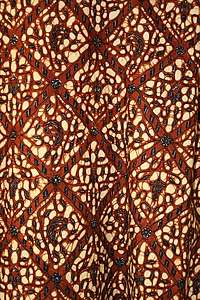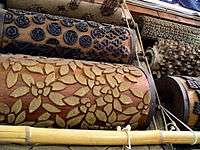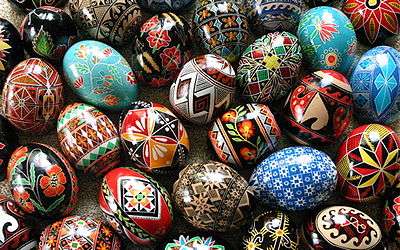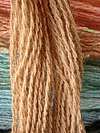Resist dyeing
Resist dyeing (resist-dyeing) is a traditional method of dyeing textiles with patterns. Methods are used to "resist" or prevent the dye from reaching all the cloth, thereby creating a pattern and ground. The most common forms use wax, some type of paste made from starch or mud,[1] or a mechanical resist that manipulates the cloth such as tying or stitching. Another form of resist involves using a chemical agent in a specific type of dye that will repel another type of dye printed over the top. The best-known varieties today include tie-dye and batik.

Basic methods
Wax or paste: melted wax or some form of paste is applied to cloth before being dipped in dye. Wherever the wax has seeped through the fabric, the dye will not penetrate. Sometimes several colors are used, with a series of dyeing, drying and waxing steps. The wax may also be applied to another piece of cloth to make a stencil, which is then placed over the cloth, and dye applied to the assembly; this is known as resist printing.
Stencils: a stencil is placed over the fabric where it is to be shielded from ink, similar to how screen prints are made.
Mechanical: the cloth is tied, stitched, or clamped using clothespegs or wooden blocks to shield areas of the fabric.
Chemical: a modern textile printing method, commonly achieved using two different classes of fiber reactive dyes, one of which must be of the vinyl sulfone type. A chemical-resisting agent is combined with dye Type A, and printed using the screenprint method and allowed to dry. A second dye, Type B, is then printed overtop. The resist agent in Type A chemically prevents Type B from reacting with the fabric, resulting in a crisp pattern/ground relationship.[2]
History
Resist dyeing has been very widely used in Eurasia and Africa since ancient times. The first discoveries of pieces of linen was from Egypt and date from the fourth century. Cloth, used for mummy wrappings, was coated with wax, scratched with a sharp stylus, and dyed with a mixture of blood and ashes. After dyeing the cloth was washed in hot water to remove the wax. In Asia, this technique was practiced in China during the Tang dynasty (618–907), in India and Japan in the Nara period (645–794). In Africa it was originally practiced by the Yoruba people in Nigeria, and the Soninke and Wolof in Senegal.[1]
Traditions using wax or paste
- Guizhou Province of China had a strong tradition of wax dyeing

Traditions using tying or stitching
Traditions using printing
- Japan- Katagami and Bingata with stencils
- China – about 500 AD the jia xie method for dyeing (usually silk) using wood blocks was invented. An upper and a lower block is made, with carved out compartments opening to the back, fitted with plugs. The cloth, usually folded a number of times, is inserted and clamped between the two blocks. By unplugging the different compartments and filling them with dyes of different colours, a multi-coloured pattern can be printed over quite a large area of folded cloth.[3]
Other traditions

See also
References
- "Batik in Africa". The Batik Guild. Retrieved April 29, 2014.
- "Vinyl Sulfone Fiber Reactive Dyes: Using Remazol Dyes for Chemical Resist Dyeing". All About Hand Dyeing. September 30, 2011. Retrieved April 13, 2016.
- Shelagh Vainker in Anne Farrer (ed), "Caves of the Thousand Buddhas" , 1990, British Museum publications, ISBN 0-7141-1447-2
